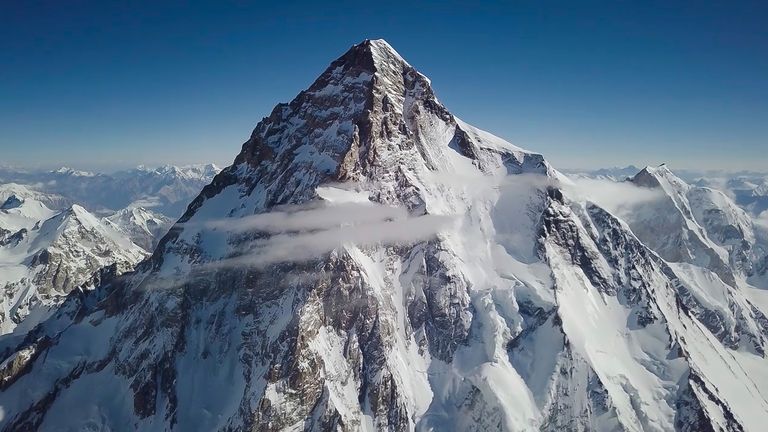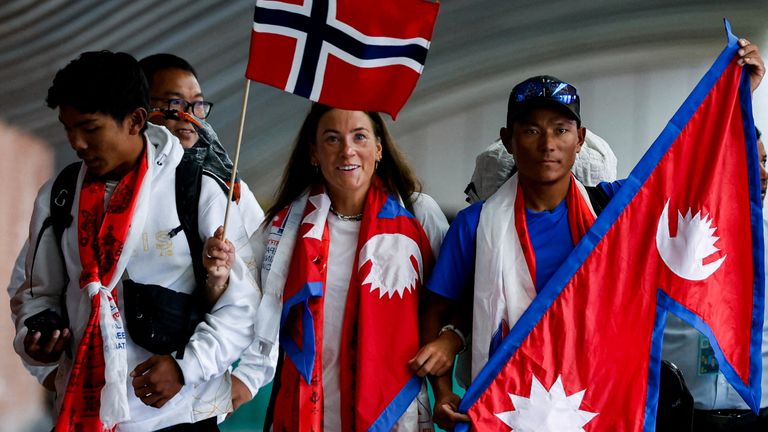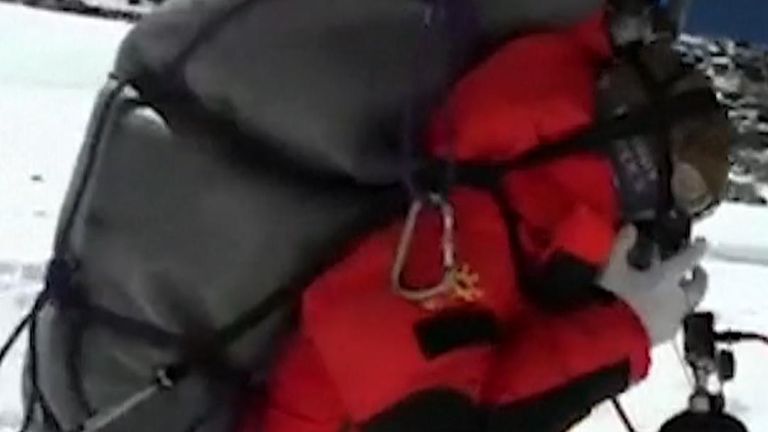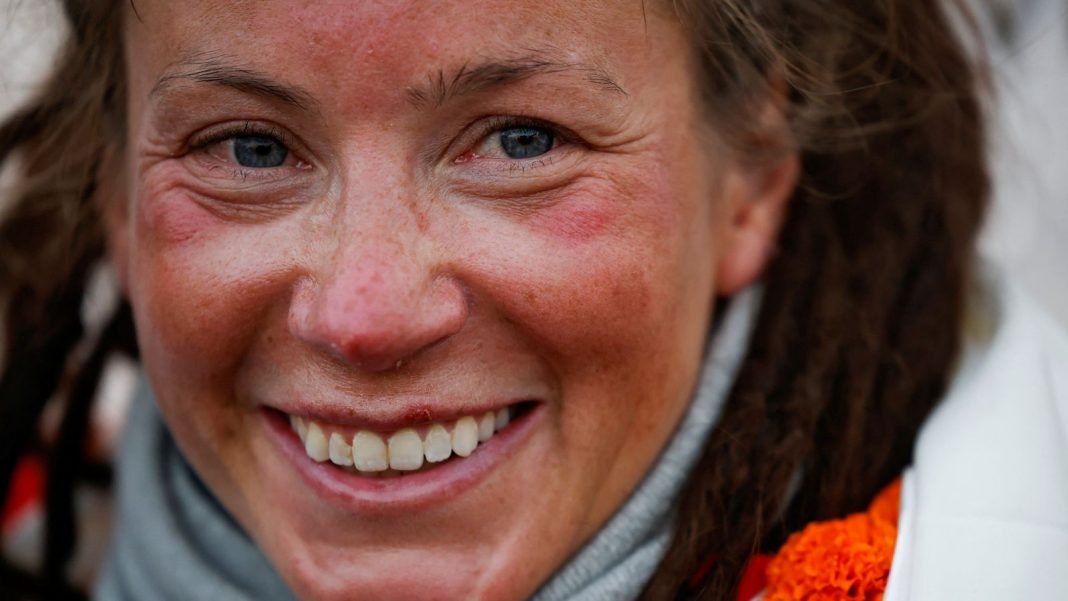A renowned Norwegian mountaineer has denied claims her team stepped over a dying helper while climbing K2 – one of the tallest peaks on the planet – as part of a world record bid.
Kristin Harila, 37, last month became the fastest climber to scale all the world’s 14 highest mountains – completing the achievement in just 92 days.
Her final climb was of K2 on 27 July, after which she returned with fellow record-breaker, Nepali mountaineer Tenjen (Lama) Sherpa, to Kathmandu to a hero’s welcome.
Norwegian mountaineer Kristin Harila with Nepali mountaineer Tenjen (Lama) Sherpa
But during the K2 climb, a local helper who was part of a team ahead of them, slipped a few metres from a narrow ledge, became tangled in ropes and later died on the mountain.
Video has emerged showing climbers appearing to step over the high porter, named as 27-year-old father-of-three Muhammad Hassan.
Two men, who were climbing K2 on the same day, have since criticised the group, and claimed Mr Hassan was treated like a “second-class human being” by other climbers.
However, Ms Harila has now responded, hitting out at the “misinformation” and “hatred” aimed at her.

K2, referred to as ‘killer mountain’, is located in the Karakorum mountain range. File pic: AP
In a post on Instagram, in which she claimed she had received death threats, she also said her team had stopped to help Mr Hassan before continuing their climb.
“I am angry at how many people have been blaming others for this tragic accident,” she wrote.
“This was no one’s fault, you cannot comment when you do not understand the situation, and sending death threats is never okay.
“This happened at the most dangerous part of the deadliest mountain in the world, and you should remember that at 8000+ metres, your survival instincts impact the decision you make.”
She said the incident happened at a “dangerous bottleneck” in the mountain, consisting of a narrow path with overhanging snow and ice.
“I did not see exactly what took place, but suddenly Hassan had fallen and was hanging on the rope between two ice anchors,” she said.
“At first, nobody moved, probably out of shock and fear, then we realised he was hanging upside down and was not able to climb up by himself.”
Ms Harila said she and her team spent around 90 minutes attempting to pull Mr Hassan up – until an avalanche took place nearby and Sherpas behind them decided to head back down the mountain for help.
“We decided to continue forward, as too many people in the bottleneck would make it more dangerous for a rescue.”
She said her cameraman stayed behind in the bottleneck for almost two-and-a-half hours as he attempted to help Mr Hassan “while people were passing by”.
This content is provided by Instagram, which may be using cookies and other technologies.
To show you this content, we need your permission to use cookies.
You can use the buttons below to amend your preferences to enable Instagram cookies or to allow those cookies just once.
You can change your settings at any time via the Privacy Options.
Unfortunately we have been unable to verify if you have consented to Instagram cookies.
To view this content you can use the button below to allow Instagram cookies for this session only.
“I don’t think people understood the gravity of what was happening with Hassan as they were climbing, and that is why we see they are stepping over him to reach safety on the other side,” she said.
Ms Harila and her team later reached the summit of K2, where she filmed an “emotional” video celebrating their record-breaking climb.
She said she only discovered Mr Hassan had died as she climbed down the mountain, and that she and her team were unable to recover his body because it was “impossible to safely carry him down”.
“It is truly tragic what happened, and I feel very strongly for the family. If anything, I hope we can learn something from this tragedy,” she added.
Following the incident, German cameraman Philip Flamig shared footage which showed climbers appearing to walk over Mr Hassan’s body instead of attempting to rescue him.
Mr Flamig, who had sent drones up to film people climbing up K2 on the day, claimed he saw around 50 people walk over Mr Hassan.
He told Austria’s Standard newspaper: “[In the footage] he is being treated by one person while everyone else continues towards the summit.

“The fact is that no organised rescue operation took place, although there were Sherpas and mountain guides on site who could have taken action.”
Austrian mountaineer Wilhelm Steindl, who was on the mountain that day but turned back because of the “dangerous conditions”, added: “Such a thing would be unthinkable in the Alps.
“He was treated like a second-class human being. If he had been a Westerner, he would have been rescued immediately.
“No one felt responsible for him. What happened there is a disgrace. A living human was left lying so that records could be set.”
Read more from Sky News:
Body of climber missing since 1986 discovered on melting Swiss glacier
Sherpa guides rescue freezing climber from Everest ‘death zone’
Please use Chrome browser for a more accessible video player

0:55
June: ‘Almost impossible’ rescue from Mt. Everest
Mr Steindl has since visited Mr Hassan’s family and has set up a GoFundMe page hoping to raise up to €100,000 (£86,500) to support them.
“He was 27 years old and had a family with three young children,” he said.
“When we found out about the family, we personally went to the mountain village to support the family.
“The mother is desperate because she has no financial means. In these remote villages, women are not educated and cannot earn money in the strictly Muslim country.”
K2 is widely regarded as the one of the hardest peaks in mountaineering – with 2018 figures showing that over a fifth of attempted ascents end in death.
Experts say K2 – the world’s second-tallest mountain above sea level – is even more dangerous than Everest – the tallest – because less of the mountain flattens off, and it is prone to avalanches and rock falls.







